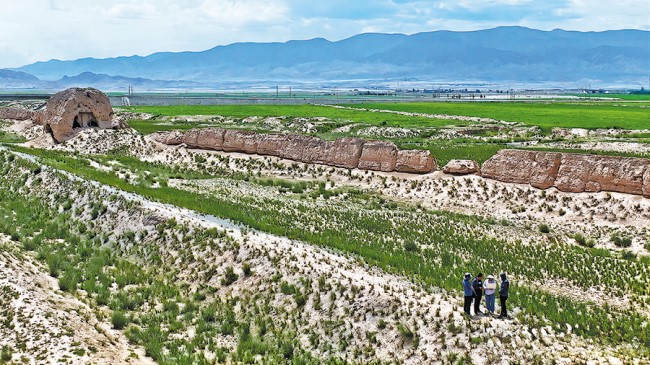From protection to patrimony

Researchers from the Han and Ming Great Wall conservation and research center of Shandan county, Zhangye, Gansu province, gather data at the site in June last year. [Photo by Wang Jiang for China Daily]
Han and Ming Great Wall protection leads to creation of national cultural park in Northwest China, Yang Yang and Ma Jingna report in Zhangye, Gansu.
In the bleak, endless expanse of the Gobi Desert in Shandan county, Zhangye, Gansu province, the ancient remains of two parallel Great Walls extend.
They were built at different times — one dates back to the Han Dynasty (206 BC-AD 220) and the other to the Ming Dynasty (1368-1644). Both run east-west, separated by a distance of between 10 and 80 meters, but they are completely different in look and structure.
The 94-kilometer stretch of the Han Great Wall is composed of trenches, rivers and beacon towers, while the 271-km stretch of the Ming Great Wall consists of rammed earth walls, mounds and barriers.
In 121 BC, Han Dynasty emperor Liu Che sent General Huo Qubing to the western region of the Yellow River to fight Xiongnu nomads in the north. In today's Hexi Corridor, which runs through Wuwei, Zhangye, Jiuquan and Dunhuang, Huo won several battles. To protect the frontier, the emperor ordered a military defense system built.
For millennia, the Hexi Corridor served as a crucial gateway from the Central Plains to the western regions. Shandan county is located in the middle section of the corridor, with the Longshou Mountains to the north connecting to the Juyan Ancient Road, and the Qilian Mountains to the south intersecting with the Tang-Tubo Ancient Road that ran from Chang'an (today's Xi'an in Shaanxi province) to Lhasa (in today's Xizang autonomous region).
It was a location that had to be passed, both on the Silk Road as well as on today's Eurasian Land Bridge, and was known as the "narrow waist of the corridor" and the "throat of Ganzhou (today's Zhangye) and Liangzhou (today's Wuwei)".








